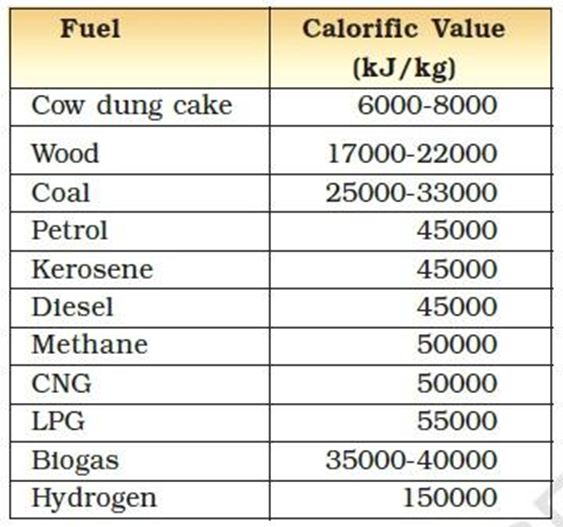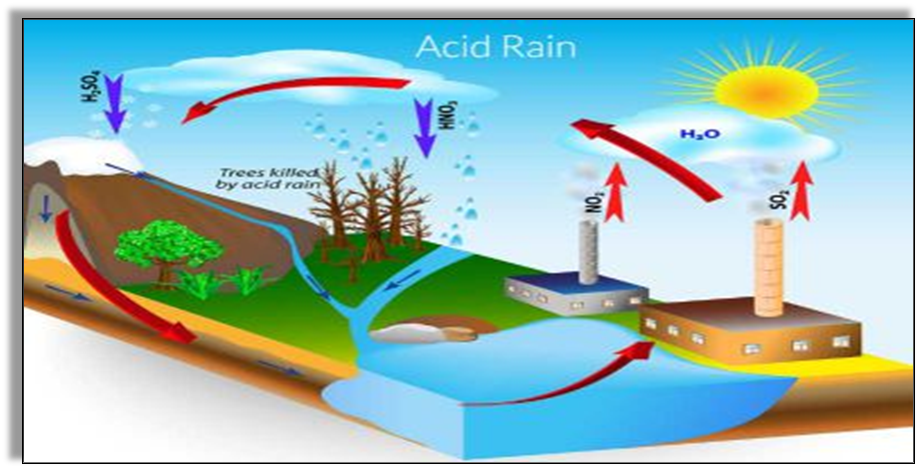- Books Name
- Class-8 Science Book
- Publication
- PathSet Publications
- Course
- CBSE Class 8
- Subject
- Science
Fuel Efficiency
Fuel efficiency of a fuel depends on its calorific value.
- The quantity of heat generated on combustion of 1 kg of a fuel is called its calorific value.
- Its unit is kilojoules per kg (KJ/kg).

If we look at the table, we will see that hydrogen seems to be the most efficient fuel followed by LPG. CNG and Methane come next, closely followed by Kerosene, Diesel and Methane. Cow dung cake seems to be the least efficient fuel here.
Uses of Fuels
Some of the ways in which common fuels are used are:
Gasoline is used in cars, scooters and other vehicles we use every day.
Natural gas is used in heating systems, water heaters, dryers, and stovetops in our homes.
Oil and natural gas are used in making several things that we use every day. Hydrocarbons, for example, are used in making plastics, pharmaceuticals and several other items we use daily.
Coal is the primary fossil fuel used in many thermal power plants to produce electricity.
If we look at the table, we will see that hydrogen seems to be the most efficient fuel followed by LPG. CNG and Methane come next, closely followed by Kerosene, Diesel and Methane. Cow dung cake seems to be the least efficient fuel here.
Uses of Fuels
Some of the ways in which common fuels are used are:
Gasoline is used in cars, scooters and other vehicles we use every day.
Natural gas is used in heating systems, water heaters, dryers, and stovetops in our homes.
Oil and natural gas are used in making several things that we use every day. Hydrocarbons, for example, are used in making plastics, pharmaceuticals and several other items we use daily.
Coal is the primary fossil fuel used in many thermal power plants to produce electricity.
Types of Fuels
Fuels can mainly be divided into three groups:
Liquid Fuels: Petroleum (which is a fossil fuel), crude oil (from which we get petrol or gasoline), diesel, kerosene oil etc.
Solid Fuels: Firewood, charcoal, coal (fossil fuel which is mined as steam coke or soft coke), dung cakes, tallow (animal fat), straw and other agricultural wastes, paraffin wax, camphor etc.
Gaseous Fuels: Most commonly used gas is LPG (Liquid Petroleum Gas) which we use as cooking gas at home. Some of the other commonly used gaseous fuels are:
We get CNG (Compressed Natural Gas) from natural oil wells.
Natural gas (or methane) gets released from the putrefying organic matter.
Butane gas is obtained from natural gas.
In the villages, animal dung and farm waste are used to produce biogas. Biogas is also collected from sewage plants.
When hard coke is heated and converted into coke, coal gas is produced.
Water-gas are produced by passing steam over red-hot coke.
Acetylene used a gas produced by adding calcium carbide to water. Its smell is a bit unpleasant but the flame it produces is so hot that it is used for cutting metals and welding purposes.
HARMFUL EFFECT OF BURNING FUEL
The increasing fuel consumption has harmful effects on the environment.
- Carbon fuels cause many respiratory diseases. It releases unburnt carbon particles.
- The partial burning of some fuels releases carbon monoxide, which is a poisonous gas. And this gas can kill a person if left in a room filled with this gas.
GLOBAL WARMING - Combustion of most fuels increases the amount of carbon dioxide in the atmosphere that has led to increase in the average temperature on the earth.
ACID RAIN - Due to the burning of coal and diesel, Chemicals like Sulphur dioxide and nitrogen dioxide are released into the air. The pollutants react with the water vapor present in the air and form sulphuric and nitric acid. When it rains, these acids are also present. Such kind of rain is called Acid Rain. It is very harmful to crops, buildings and soil.

Prevention from Acid Rain: The use of diesel and petrol as fuels in automobiles is being replaced by CNG (Compressed Natural Gas) because CNG produces harmful products in very small amounts. CNG is a cleaner fuel. Carbon fuels like wood, coal and petroleum release ash and fine unburnt carbon particles in the air which can cause respiratory diseases like asthma. These fine particles are referred to as Suspended Particulate Matter (SPM). Incomplete combustion of fuels (such as coal, gasoline and other fossil fuels)releases carbon monoxide gas which is very poisonous and can kill people sleeping in the room where coal is burning. CO combines with hemoglobin in our blood to form carboxyhemoglobin and renders it incapable of transporting oxygen.
These fuels also release unburnt hydrocarbons, many of which are carcinogenic (cause cancer) and pose serious health hazards. Carbon dioxide released by most fuels during combustion is causing an imbalance in the atmosphere. Deforestation is also leading to a situation where there are fewer trees to absorb the carbon dioxide. This is leading to global warming. The burning of coal and diesel releases Sulphur dioxide gas which is corrosive in nature and causes irritation in the nose, throat and airways. It also causes shortness of breath, wheezing, and a feeling of tightness around the chest. Petrol engines release gaseous oxides of nitrogen. These sulphur and nitrogen oxides dissolve in rainwater to form acids and cause acid rain.
Global warming is the rising temperature of the Earth's atmosphere which is causing the melting down of glaciers making the sea levels rise and causing floods in coastal areas. It is caused due to the elevated levels of carbon dioxide in the atmosphere as CO2 absorbs infrared radiation emitted by the Earth and radiates it back to the atmosphere and raises its temperature. This is also known as the ‘greenhouse effect.
Acid Rain refers to the rain of acids that is very harmful to crops, soil, animals, and buildings. These acids are formed when sulphur and nitrogen oxides dissolve in rainwater. Acid rains also damage trees at high elevations (such as red spruce that grows 2,000 ft above sea level), cause acidification of lake or stream water, and damage forest soils. Irreplaceable buildings, statues and sculptures which are part of a nation’s cultural heritage can get destroyed due to acid rain.
Why do we not burn wood anymore?
Wood is a low-cost fuel and is easily available but burning it releases a lot of smoke which causes respiratory problems. Moreover, cutting of trees for wood (as fuel) also leads to deforestation. Hence, people now prefer to use coal or LPG as fuel instead.
Why should we use CNG as automobile fuel?
CNG is a cleaner fuel and causes much less pollution than petrol and diesel. Hence, we should use CNG-powered vehicles now.
How to Conserve Fuels?
To conserve fuels, we should:
- Collect all material required while cooking at one place before switching on the gas
- check the pressure of tyres regularly
- choose walking overusing cars or motorbikes for short distances
- use public transportation for traveling instead of private vehicles.

 PathSet Publications
PathSet Publications
